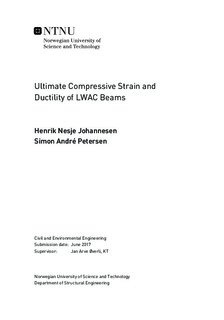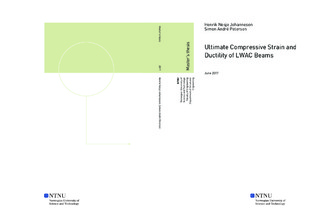| dc.description.abstract | The purpose of this master thesis was to investigate confinement and ductility of lightweight aggregate concrete (LWAC) in compression. The main characteristics of LWAC in general are brittleness and uncontrolled crack propagation. Because of this, structural applications of LWAC is reduced compared to structural applications of NDC.
To test confinement of LWAC, seven over-reinforced beams were loaded in four point bending. To achieve confinement of the tested beams, shear reinforcement was introduced. The geometry of the beams was 210 x 550 x 4500 mm (width x height x length). The test setup was designed to produce a constant moment zone of 1 m between the loading points. All the seven beams were designed to fail in compression between the two loading points. To compare results, the geometry of the beams was equal to the geometry used in a previous experimental study. The main test parameters that have been varied in this experimental study were stirrup spacing, amount of compressive reinforcement and size of concrete cover. Stalite with fraction 1/2" was used as aggregate for the whole test programme. All beams and small specimens were casted from the same batch of concrete. The compressive strength and oven-dry density of the concrete used in this study was 65 MPa and 1834 kg/m^3 respectively.
Four of the tested beams showed ductile behaviour. The beam without stirrups in the testing zone (between the loading points) did not show any ductile behaviour. All the beams were in the range 88-99 \% of the calculated capacity. The beams with smaller stirrup spacing in the testing zone, showed more ductile behaviour. The beams with the largest concrete cover showed the largest capacity drop after the maximum load was reached.
The test results indicated that reduced stirrup spacing gave an increase of ductility, with an exception of results from one beam. An increase of concrete cover decreased the confined area, generally leading to a reduction of ductility. The beam with a larger amount of compressive reinforcement showed an increase of ductility and capacity. Based on the experimental results of this study, it is possible to increase the ductility of LWAC structures and bring the application level of LWAC closer to the application level of NDC. | |

